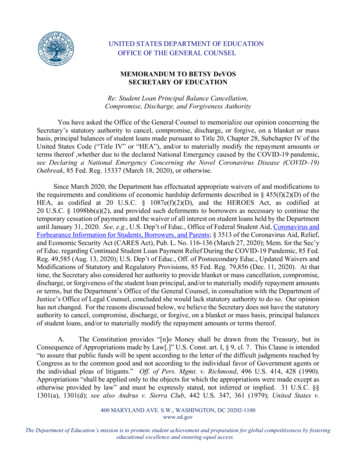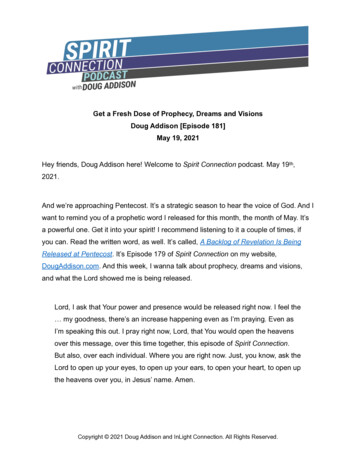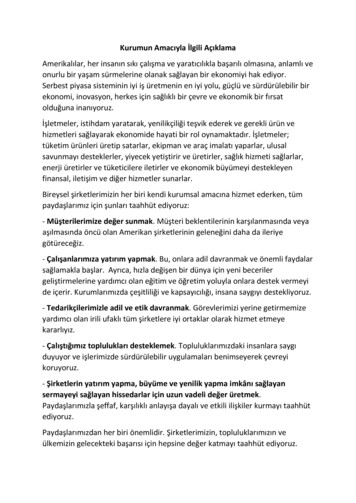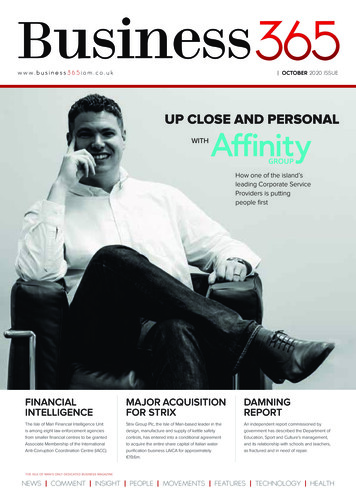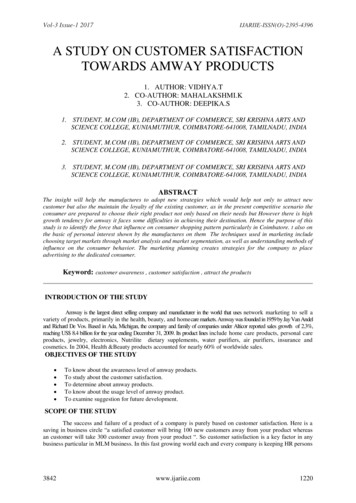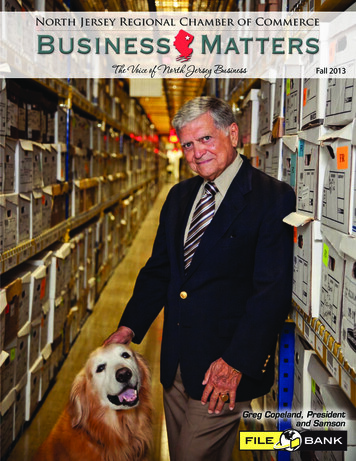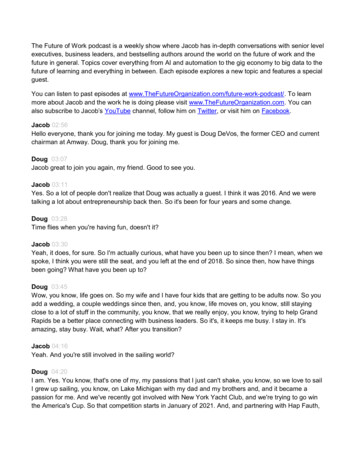
Transcription
The Future of Work podcast is a weekly show where Jacob has in-depth conversations with senior levelexecutives, business leaders, and bestselling authors around the world on the future of work and thefuture in general. Topics cover everything from AI and automation to the gig economy to big data to thefuture of learning and everything in between. Each episode explores a new topic and features a specialguest.You can listen to past episodes at . To learnmore about Jacob and the work he is doing please visit www.TheFutureOrganization.com. You canalso subscribe to Jacob’s YouTube channel, follow him on Twitter, or visit him on Facebook.Jacob 02:56Hello everyone, thank you for joining me today. My guest is Doug DeVos, the former CEO and currentchairman at Amway. Doug, thank you for joining me.Doug 03:07Jacob great to join you again, my friend. Good to see you.Jacob 03:11Yes. So a lot of people don't realize that Doug was actually a guest. I think it was 2016. And we weretalking a lot about entrepreneurship back then. So it's been for four years and some change.Doug 03:28Time flies when you're having fun, doesn't it?Jacob 03:30Yeah, it does, for sure. So I'm actually curious, what have you been up to since then? I mean, when wespoke, I think you were still the seat, and you left at the end of 2018. So since then, how have thingsbeen going? What have you been up to?Doug 03:45Wow, you know, life goes on. So my wife and I have four kids that are getting to be adults now. So youadd a wedding, a couple weddings since then, and, you know, life moves on, you know, still stayingclose to a lot of stuff in the community, you know, that we really enjoy, you know, trying to help GrandRapids be a better place connecting with business leaders. So it's, it keeps me busy. I stay in. It'samazing, stay busy. Wait, what? After you transition?Jacob 04:16Yeah. And you're still involved in the sailing world?Doug 04:20I am. Yes. You know, that's one of my, my passions that I just can't shake, you know, so we love to sailI grew up sailing, you know, on Lake Michigan with my dad and my brothers and, and it became apassion for me. And we've recently got involved with New York Yacht Club, and we're trying to go winthe America's Cup. So that competition starts in January of 2021. And, and partnering with Hap Fauth,
and Roger Penske, and the New York club has just been a great, a great experience. And so we'rehoping that the American magic team can get it done.Jacob 04:56Yeah, well, I'll be rooting for you guys. Come January. So for people watching who are maybe notfamiliar with Amway as a company, maybe you can give us a little bit of background information aboutthe organization, how many employees you guys have? What do you guys do?Doug 05:10Sure, absolutely. Amway's a direct selling company started about 60 years ago, global in scope todayabout 8 billion, little over that worth of sales globally, about 15,000 employees. But as a direct sellingcompany, we work through a group of independent people who literally own their own business sellingour products. And there's about a million people around the world who do that some make it a full time,business endeavor for themselves some part time, and many, just occasional.Doug 05:43But that's how our business operates. We have primarily wellness products that we sell our Nutriliteline, then we have beauty products, we have a variety of other products, over 400 products that we'vedeveloped over the years that we sell. And it's a it's a beautiful, you know, of course, I would say thatit's a beautiful business, wonderful people, like I say global in scope, and that's really a special part of it.Because when it comes to, you know, opportunity, the Amway business provides opportunity toeverybody wherever they're from, through their own initiative, the hard work and, and that's what myfather and his partner Jay Van Andel believed, when they started Amway, they believe that everybody,anybody, if given the opportunity would do something with it. And so they wanted to provide a businessopportunity for everyone.Jacob 06:36Very cool. So one of the things they realized they didn't ask you, when you were on the show last time,is just a little bit of background information about yourself. So I'm really curious, how, how did you growup? How did you eventually get to become the CEO of Amway? What was it like, you know, your familystarted this, this really amazing company? And what was it like growing up?Doug 06:56Well, it's a funny story, because my father and Jay were friends in high school. And so, so right, afterthey got married, they wanted to live to get near each other. So we were actually neighbors of the VanAndel family as we grew up, so and it was a small town of Ada, Michigan, just outside Grand Rapids.So there weren't a lot of other people around in Ada at that time. So everything in our experiencegrowing up was Amway.Doug 07:24Again, the nature of our business, we had employee events, we had, you know, business owner eventsat the house, so you were just in completely overwhelmed and part of the organization and loved it fromthe beginning. So, uh, so we would work there, you know, after after school, you know, in high school,and then through college. And then after I graduated from Purdue, I wanted to work there full time. And
so program work in Europe. I moved to Brussels, Belgium, and worked as a European sales managerthere and then kind of had different roles in different parts of the company parts. And, and, and thenthey had a chance to lead it for a number of years, which was just a tremendous blessing.Jacob 08:13Very cool. That's Yeah, it's quite a story on so early on. How big was Amway? I mean, was it like 510people that eventually grew to 15,000?Doug 08:24It was it was a very small, a very small organization here in Ada, Michigan, it basically started out of thebasements of our house and Jays house. You know, they had a direct selling experience, dad and Jaydid, they ran with a company called Nutrilite, selling wellness products. And they did that for about 10years, then for a variety of reasons they made some changes and started Amway.Doug 08:51And they started out their basements with just the two of them. And, and it went from there. So whowould have imagined it would have turned into what it is today, and it is, in the early 70s, we werelooking for a wellness line and went back and Amway bought Nutrilite really kind of put the band backtogether again, if you will. So it's a great story.Jacob 09:13Were there any times during the history of the company where you thought maybe the company wouldgo wonder or go out of business? Somebody was trying to take you over? And did you have any liketough, tough hurdles you guys had to get through?Doug 09:27Well, we've had a lot of tough hurdles. You know, because the business model, our kind of model ofdirect selling, to a certain extent was unknown. So it was challenged in the 1970s, here in the US by theFederal Trade Commission, was it legitimate? Was it not? And that was a huge risk and a hugechallenge that we faced some of that around the world and in fact, today, Amway China's our biggestmarketing app shortly after we started there in the mid 1990s. We were challenged there, there was aquestion of the legitimacy of the business model.Doug 09:59Obviously, it's been validated and verified there and in all markets around the world of how ourbusiness model operates. So from that perspective, there's been some, you know, some stormyweather. And then we've had some just market challenges where we've had markets that have, youknow, had some great successes; we've had some great challenges. And so it's been an ongoing cycleof adjusting and adapting, but still always moving forward.Jacob 10:28And what about how current events today have impacted the business? You know, we've been seeinga lot with COVID, with Black Lives Matter, the kind of social and racial injustice, that's going out there?Is this impacted me at all? And have you guys done anything?
Doug 10:45Well, you know, boy, you know, the marketplace always impacts, you know, what we do? You know,and I think probably the best way to articulate it is to say, we've always understood who we are, andwhy we do what we do. And so when things change dramatically around us, we have a foundation to goback to. We know, we know this, we know what we're trying to accomplish, we know who we're workingwith, we know how to how we want to approach the market.Doug 11:13And so the market adjusts and adapts, we have a foundation from which we can move, and be agile,and, and still stay connected to the marketplace. So and when these things happen, when you talkabout injustice in the world, we go back and say we have provided an opportunity for everybody,anybody from the very beginning. So we have we can express our values through how we operate. Youknow, because we've been doing it ever since we began so we don't have to make something up or tryto catch up or adjust. But what we do have to do is look at ourselves honestly and say, can we do itbetter? Can we provide a better opportunity for more people, that becomes more real, and can we givethem better products to sell and better support with technology and, and operations?Doug 12:07Those are the things that we have to challenge ourselves and be honest to say, you know, in someaspects of the business, we could be better, we should be better, and we will be better. And that's howwe want to look at those sorts of things. So you know, so you know, and if you take maybe you know,the health issues of the pandemic, and you say, well, we've always been talking about wellness, we'vealways been talking about prevention, we don't talk about cure, we talk about being healthy, and livinga healthy lifestyle, which would prepare you for this sort of a situation or any other kind of a situationthat you may have.Doug 12:42So we go back to our values, to be able to adjust and adapt and meet the marketplace, where it is.That's how we tried to approachJacob 12:51Has COVID impacted, I mean, obviously, direct selling and probably made it challenging for a lot of thepeople with Amway. So you guys had to adapt or find kind of creative ways to still be able to do directsellingDoug 13:07Oh absolutely. It's, it's, it's changed, you know, virtually everything about how we operate, not who weare, but how we operate. We love meetings, oh, we love traveling the world, we love getting together,we love doing all these fun things together. Can't do that anymore. We love demonstrating productspersonally with customers and in recruiting new people to start their own businesses. Can't do it thesame way anymore.
Doug 13:34So the beauty of an entrepreneurial organization or a business full of entrepreneurs, they adjust quickly,you know, they move because they have to, they're on the front lines. And because of the nature of ourbusiness model, we don't have a lot of capital infrastructure that they have to deal with. They buy acomputer, they do things differently. They figure out online, old and young, they figure out how to adapt,they figure out how to adjust. And so our business has transitioned through this pandemic, prettysuccessfully.Doug 14:09Now we you know, we were actually performing better than we had expected before things hit. So we'reeveryone's scrambling in our workplace, okay, we're all working remotely. We're doing thingsdifferently. Our manufacturing facilities, we all we had to adapt all of our manufacturing processes in amatter of months, because as I said earlier, we operate in China. we first saw it there. We saw it inEurope. So we went adapting and by the way, we've been telling other businesses how we've done it.We've been comparing notes with other global businesses, especially here in Michigan. So what areyou learning? What are you learning? Here's what we can do to adapt, adjust.Doug 14:47And so there's no trade secrets, everybody-- I thought it was a real special aspect of the businesscommittee--everybody was sharing best practices with each other to say how can we do you know howcan We make sure our employees, our customers stay safe in this new environment. And soeverything's changed, but we've been able to continue to operate.Jacob 15:09There's a couple of people who are watching live, one person said that their mom was at Amway 50years ago. Somebody else, Jade, says her cousin brought Amway to Turkey. So you definitely havesome people who are watching who themselves or their family members have been a part of Amway,which I think is pretty cool.Doug 15:31Wonderful.Jacob 15:32So it's interesting. You talked about having to adapt. Did you have any stories or examples of howsome of these entrepreneurs have had to adapt? Just so that people can kind of get a vision? I'massuming it had to move towards online towards the internet. But how I mean, what did that adaptationlook like?Doug 15:55So so I'll give you an example. Just yesterday. Amway Korea would have our national convention wewould have it at the sometimes the Olympic Stadium, we'd get 10s of thousands of people, we'd have ahuge event we bring in big acts we'd have you know, we have great you know, entertainmentcamaraderie, business content, you know, product expos all around the facility. Yesterday we did it witha with you know, completely online I dialed in from here are our new CEO Milind Pant, he dialed in from
his home. You know, we had other executives that that joined, you know, virtually, we had, you know,leaders inside the business, they're all joined virtually, there's a great studio with a host with, withscreens all around behind them.Doug 16:45So kind of like if you're watching NBA game, you got people participating on the screens that arearound the stage. So it, we tried to create a great feeling again, but that was one of the adaptations thatwe just had to do.Doug 16:58And the other thing is really the move online. As I said, we love the personal interaction. But with froman e commerce perspective, we've been moving in the e commerce direction for a long time, just took ahuge uptick, as you can imagine, where everybody really started to use, you know, that capability, it puta lot of stress on us. And, you know, sometimes we weren't as good as we thought we were inexecution. But those are some of the main examples that we've seen.Jacob 17:29Well, it seems like you guys had to reinvent yourselves a little bit as well to kind of adapt to this newworld that we're all a part of. And maybe we can talk a little bit about the leadership component,because obviously leading now behind the behind the screen, you know, you have 15,000 people, yousaid over a million people who are involved with Amway, how do you engage and motivate and inspireall these people when you're behind a webcam and behind a computer?Doug 17:55Sure, again, the beauty of the entrepreneurial spirit is that they inspire themselves. What we do is wemake sure we provide the infrastructure, the foundation, we make sure that the product quality is there,the innovation is there. So that when they're representing the product, when they're talking about it to anew customer or prospect that they can have confidence in the work that's behind them, we've talked alittle bit about the, you know, the technology components and things of that nature.Doug 18:24Our job is to make sure that that original idea that anybody can have a business of their own, thateverybody should have access to a real opportunity to achieve the goals that they want to achieve. Andso our role is to is to find a lot of new ways to keep communicating that message and not justcommunicating it, demonstrating it by new product introductions, new promotional incentive campaigns,new business support operations that we have, so that when they see it and feel it, it allows them toinspire themselves.Doug 19:07Because it's always been about them and their goals, they may want a full time income, they may wanta part time income or something else. Like I said earlier, our job is to help them achieve where they areand so however, the method is it's the message in my opinion, that's the vital part, and that we continueto be, you know, laser focused on providing that opportunity for people.
Jacob 19:35What about for people who are not, maybe on the direct selling side, but kind of in the back office, youknow, people who are running marketing, HR, you know, people who are more full time at Amway?How do you motivate and engage and inspire those types of team members. So I'm assuming you stillhave to think about like talent development, leadership development, recruiting new employees, Imean, all the traditional aspects of basically running a business.Doug 20:00Oh, absolutely. And so, you know, the big thing in that component is to make sure we continue to notonly talk about our foundations, but express a vision, here's where we're going, here's how we'reunique in the marketplace, here's what's creative and new, that you can experience as a leader in themanagement of a company like Amway, here's what we can demonstrate, here's how we can, youknow, create a market that special and new and not only reaches a customer with a product, but helpssomebody have their own business along the way.Doug 20:39And then it's through being much more collaborative. And actually, some of the things that we found inthe global business, we can break down a few barriers with technology. So we've found some waysthat we can almost connect more often stay in touch more often than we would in the past, we woulddelay things, well, I'll talk to you about it when I when I fly over there next month, or, or some othertime, because we're so relational. And so we've had to learn new skills, and new ways ofcommunicating where the company is going of staying on top of things and working really quickly.Doug 21:17Because the market's moving fast, and we have to adapt quickly, as well. And I'm really proud of thewhole management team around the world for what they've done. To adapt, again, I've transitioned so Iget to watch and cheer. And really marvel at the way the business has made those adaptations.Jacob 21:41Were there any new practices or policies or things that were put into place inside of Amway thatallowed for these adaptations, just trying to learn a little bit more about some of the things that you guysdid, so that other people watching might be able to implement some of those things in their companies.Doug 21:58Sure, we focused on culture, we, in fact, what we tried to do is with policies that were in place, we triedto put a pause on them, rather than trying to think you know, top down, here's how we're going to directit, we're going to trust everybody to understand that we're working in a different environment. And soone of the things we did is we really increased our communication dramatically, we would do anemployee survey every two years, how's it going? What's happening? We're doing them every 30 days,you know, quick, quick, you know, you know, quick shots, what's happening in this market? What'shappening in that market? What are you sensing? What are you feeling so we can adapt and adjust.
Doug 22:36And really, from a policy standpoint, kind of put things on hold and say, Look, we're gonna trust you tobe responsible, we know you're going to work. And you were going to have to do it differently. Becausewe can't do it the way we were, we're going to trust you to do it. And we've been rewarded dramatically,because the productivity has stayed the same or even increased. And we know a lot of people aredoing it tough circumstances, you're working at home in a different environment, it's one thing youknow, in my situation, our kids are grown, they're out of the house, you know, we're fine. If you've got,you know.Jacob 23:09I have two kids, a four year old and a four month old.Doug 23:13There you go.Jacob 23:14I'm feeling the pain, man, I'm feeling the pain,Doug 23:16Not so easy is it? You know, especially in some countries where they're not coming back to going backto school, so you don't have that normal break in the routine either. So what we've tried to do from apolicy standpoint is say, you know, let's put those on hold. Let's focus on culture, how are we adapting?How are we adjusting? How are we staying focused, and we're gonna trust people to be responsible tostill stay productive, and that's really happened.Jacob 23:41So what are some of the traditional I guess, policies that you guys put on hold that you kind of said, youknow, don't worry about this for a little while until things get back to normal?Doug 23:51Well, you know, vacation policy, you know, attendance policies, certainly in the manufacturing space, ifwe have to be a little bit different, because people do have to be there physically, but how they, howthey, you know, how they arrive, how their, how their workspace is configured, you know, those sorts ofthings have had to change. So we, you know, we've really tried to make sure that, that we'readdressing everything that they're going to have to have from their side so that they feel safe, that theyfeel rewarded.Doug 24:24I think our evaluation systems, you know, again, be gone. You know, we had an annual evaluationsystems, we're doing those every 90 days, just more checking in what's working, what's not working, it'sreally not an evaluation. It's a coaching system. That's the, that's what we want to have with our work.You know, again, in the manufacturing side, the workspace environments changed. We wanted to dothat more with the had planned to do it a little differently on the on the office side, if you will, but COVIDhas changed all of that. So, you know, so we don't really have a physical workspace in the same way.
It's more of a virtual workspace now, although we are having, in some markets, some people comingback in from time to time, but it's a different workplace.Doug 25:08So I think to your point, you know, it's it's letting people and letting people express themselves in aproductive and helpful way business going forward, we've tried to, you know, to a certain extent, letthem lead and we can follow in support.Jacob 25:23So I'm trying to think of just kind of like broad buckets of how you guys have had to reinvent, it seemslike one was a heavy investment in, in technology, things like e commerce. Another area was inworkplace policies and practices, you've had to kind of pause some of your traditional workplacepractices, maybe even get rid of them and kind of adapt them seems like another area was aroundcommunication and collaboration and increasing that.Jacob 25:50You mentioned going from like doing these surveys every two or three years to now every 30 days, itseems like a performance management system is changed, now you're doing a lot more morecoaching, doing something a little a lot more speedier, so to speak. Any other areas or buckets that youthink we're missing as far as how you as an organization, have had to reinvent yourselves.Doug 26:16Well you know, I think you've found the big ones out of there. You know, it's the only other thing I'd addis, like I was trying to get to it, just, it's a, it really does get to the cultural side of believing in people, webelieve that people given an opportunity can have a business of their own and be successful, we feelthe same way with our employees, they want to work, they want to be productive, they want to do well.And so when we allow that to happen, we can follow their lead.Jacob 26:47Culture is, uh, you know, it's talked about by. it's everywhere, right? Every company always talksabout culture. How do you guys think about culture internally? I mean, how do you how do you explainit? How do you define it? What is the Amway culture like?Doug 27:01Well, we want start with your heart, right, you want to get on it, you want to have this, you know, thisheart for the business, heart for other people, I remember an interaction I had with a group ofemployees once. And we had, we had done some program to kind of help communication and fostercommunication amongst a manufacturing team. And they began to say what that meant for them. Andthere was one person who said, you know, this, this guy next to me, I couldn't stand him. It was theworst thing in the world. Before we started this thing, I just couldn't stand working with him. I didn't evenreally even like him.
Doug 27:38But because we had to talk, I found out what he was dealing with, when he wasn't at work, I found outthat his home situation was really tough, he had some huge burdens that he was bringing to work. Andwhen I understood that I stopped to approach him as a person first, before a colleague or a co worker,our relationship has just bloomed. I love this person now, because I know who they are.Doug 28:03So we want we want to lead with our heart, we want to have a creative mindset, we always want to beinnovative and, and thinking, you know, if I go back to the, the time of my dad and Jay, again, theywould tell a story, it's after World War II, that, you know, the world was available to them, they justcome out of the service, they wanted to start their life. And that that enthusiasm, that energy that wecan do it, we can accomplish anything sort of mentality. We want to have that as part of our operations,as well.Doug 28:37So those are two critical elements, I think that we spent a lot of time talking about that we really want to,you know, build that culture that we lead with a heart, and that we have this growth mindset, we'realways creative, are always thinking of new ways to move forward.Jacob 28:54I love the leading from the heart component, because it seems like now we need that more than ever.There are some stories in the media of companies that maybe have not been leading from the heart,you know, firing thousands of employees going through tough times. And then you see other stories ofleaders who are trying to be more compassionate leading from the heart, you know, trying to get thereto understand their employees as human beings, not just as workers.Jacob 29:18So I love that focus of leading from the heart, how do you get your other leaders to, to embrace thisconcept? I mean, is it at odds of like, is leading from the heart, is it mutually exclusive to trying to makemoney or can you balance both of those things together?Doug 29:41Boy yeah, I think it's foundation to being successful. Because until you, you know, leading from theheart doesn't mean you don't hold people accountable. It doesn't mean you don't set targets and goalsfor yourself or for others. It just means that when you're working with people, you work with themdifferent differently, that you don't, you're not a boss with a subordinate, you're a leader with a team.And so your role, you begin to think of your role differently of bringing people in.Doug 30:11And, I know there's a lot of situations where business has been unbelievably disrupted. And, and Iknow there's a lot of business owners that are just broken up because they can't keep their employeesin their current situation, they just can't afford it, they can't make it happen. And, and so that doesn'tmean you have that you don't have empathy, that you don't have cares and concerns. But you're tryingto balance you know, some of those sorts of things. But you can still lead with your heart in that
process. And be honest with your employees, you tell them what's going on, you do the most that youcan to help them transition through you. You're talking to other businesses that aren't going through thedisruption and say, Hey, I get great employees that maybe you could hire.Doug 30:55We did this years ago, when we had a downturn, we just scoured, or area in Grand Rapids, weconnected with as many other businesses as we could, we said, Look, we're struggling right now. Butsome of those people who are doing really well and said, you know, if you're looking for somebody withthis talent, boy, we might have some people who could really help your organization out. And weworked really hard at placing people. So even though we couldn't provide the ongoing employment thatwe wanted to, we were still able to invest in them as individuals, because just because they weren'tworking for us anymore, didn't mean they lost value, didn't mean that their talent went away.Doug 31:35Because of the job with us, they still had that that was their talent, their value, they just, we just wantedto help facilitate it. So they could apply it for somewhere else, because we couldn't provide them thesame opportunity in those sorts of times. And so I see that leading with a heart, it really doesn't takeaway from accountability or challenge or effort or anything like that.Jacob 31:58I love that message that even during tough times, even if you can't afford to keep or pay all yourpeople, you can still lead with empathy and help take care of them. Even not to use a terrible metaphor.But as the as the ship is kind of going down, you can still make sure that your people are, are takencare of, and they can kind of find safe passage. So I love that it's kind of like a sad metaphor to think ofas the ship is going down. And you're the captain going down with the ship and trying to help as manypeople as you can. But I think it's a suitable metaphor.Jacob 32:28So somebody who is watching live, Leandra was asking, what are your, they were asking about yourconcerns for next year, but I think maybe we can expand that a little bit broader to just when when youlook at what's happening in the world now, what are some of the things that maybe you are worriedabout in the world of business? Either next year or in the coming years?Doug 32:51Yeah. You know, I think the, you know, the challenges that we're going to face when you go throughtough times. To me, all co
7kh )xwxuh ri :run srgfdvw lv d zhhno\ vkrz zkhuh -dfre kdv lq ghswk frqyhuvdwlrqv zlwk vhqlru ohyho h[hfxwlyhv exvlqhvv ohdghuv dqg ehvwvhoolqj dxwkruv durxqg wkh zruog rq wkh ixwxuh ri zrun dqg wkh
